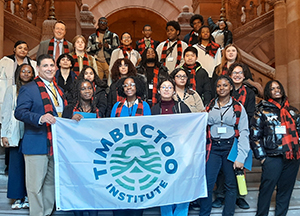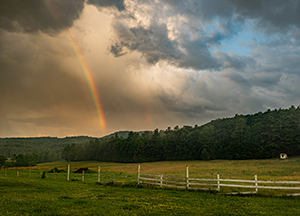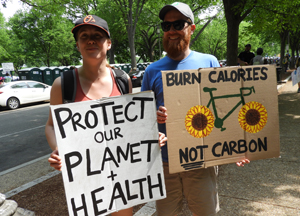
Adirondack Council Reaffirms Commitment to Protection of Whitney Lands, Wilderness and Strong Communities
FOR IMMEDIATE RELEASE: Wednesday, June 4, 2025
Texas Resort Developer to Purchase Whitney Estate, Shares Plans for Development
LONG LAKE, N.Y. -- The Adirondack Council said it was concerned to learn that a Texas-based developer had signed a contract to purchase the 36,000-acre Whitney estate here for $125 million, announcing plans to disrupt the ecological heritage of the area by building additional homes, a hotel, and golf course.
However, the organization said the purchase marked the beginning – not the end – of a new discussion about conservation of the vast tract of unbroken forests, lakes, and wetlands in the heart of the largest park in the contiguous United States.
“The Adirondack Council has been advocating for the highest level of protection for the Whitney estate lands for more than 40 years. Our mission remains clear: to preserve the wild character and ecological integrity of the entire Adirondack Park,” said Raul J. Aguirre, Executive Director of the Adirondack Council. “We are committed to finding lasting solutions that protect these critical lands while supporting strong, sustainable communities.”
“The Council has been at the forefront of these issues for 50 years and our staff and supporters understand the complexity and nuance involved, especially with a property as ecologically significant as the Whitney estate, and the dollars involved. Our commitment to protecting this land and ensuring its conservation for future generations is unwavering."
A Vital Ecological Asset
More than twice the size of Manhattan, the Whitney estate is also 33% larger than the sprawling Disney World Resort’s collection of theme parks in Orlando.
One of the most ecologically important private estates within the Adirondack Park, it sits at the heart of an Adirondack Council proposal to create a 600,000-acre wildlands complex that would span the north-flowing Raquette River and Oswegatchie River watersheds.
Bejeweled with 22 interconnected lakes and ponds, these lands have been a priority acquisition for New York’s Open Space Conservation Plan since 1992, due to their high-quality wildlife habitat, recreational potential, and pristine waters.
The Whitney property is crucial to linking six existing state Wilderness Areas into a vast, interconnected wild landscape. This would create an ecosystem large enough to support the habitat needs of vanished species, including the potential return of the gray wolf, a species historically native to the region. The proposed Bob Marshall Great Wilderness, first outlined in the Adirondack Council’s 1988 report 2020 VISION: Fulfilling the Promise of the Adirondack Park, and further detailed in the 1992 publication A Gift of Wildness: The Bob Marshall Great Wilderness, is key to this vision. This concept was incorporated into the New York State Open Space Conservation Plan as the Oswegatchie Great Forest.
A Legacy of Conservation
Currently, the Whitney property is managed as a private retreat and commercial timberland, with a few large home sites connected by narrow roads. For over a century, the Whitney family has maintained the property as a forest, prioritizing conservation over development, and taken advantage of numerous tax breaks and incentives. The state of New York pays full property taxes to towns within the Adirondack Park for Forest Preserve lands, often at higher rates than legacy properties pay.
“The Whitneys have shown true conservation stewardship, and we aim to find a solution that would honor this legacy while ensuring its preservation for generations to come,” Aguirre stated. “Rather than developing homes or golf courses over the past 100 years, they’ve kept this land intact—and that is a testament to their commitment to the careful stewardship of this property.”
Preserving the Land for the Future
In 2021, a proposal by John Hendrickson to subdivide the property into 11 lots and sell them to separate buyers raised concerns among conservationists. Experts warned that such a subdivision would threaten the land’s ecological health, with risks of invasive species and habitat fragmentation. The proposal was never submitted to the Adirondack Park Agency for approval. Conservation groups have emphasized that any conservation plan for the property would require a mix of public and private investment, ensuring that parts of the land remain in private ownership while still protecting the majority of the estate.
“New York can protect the vast majority of this property in partnership with the landowner, while also allowing for economic development that benefits the local community of Long Lake,” Aguirre noted. “This is a unique opportunity to balance conservation with sustainable economic growth.”
A Critical Step for Biodiversity and Climate Action
As New York State continues its efforts to advance biodiversity and climate action through initiatives like the Open Space Plan, State Wildlife Action Plan, and 30x30 goals, protecting the most sensitive and wild parts of the Whitney estate is an essential step in these efforts. The protection of this land will help sequester carbon, improve water quality, and support biodiversity across the northeast, all while increasing recreational access in Hamilton County.
Aguirre also pointed out the ecological importance of the property’s interconnected waterways, which form part of a historic 19th-century canoe route.
“The Whitney property provides vital ecological connectivity, not just for the central Adirondacks but for the broader region,” Aguirre explained. “The property’s recovering forests will provide significant carbon sequestration benefits, helping New York State address its greenhouse gas reduction goals.”
Founded in 1975, the Adirondack Council is a privately funded, not-for-profit organization committed to protecting the ecological integrity and wild character of the Adirondack Park. The Park contains one of the largest intact temperate forests in the world and is home to approximately 130,000 New Yorkers.
The Council advances its mission through research, education, advocacy, and legal action. It envisions an Adirondack Park with clean air and water, core wilderness areas, working farms and forests, and inclusive, thriving communities.
For more information: John Sheehan, Director of Communications, 518-441-1340




